|
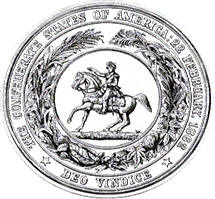
Our Confederate Ancestor

PRINT Version
of this article
Link to
National Society of the
Sons of Confederate Veterans Back to

 |
INTRODUCTION
The American
Civil War (1861–1865) was a war between the United States
Federal government (the "Union") and eleven Southern slave
states that declared their secession and formed the Confederate
States of America, led by President Jefferson Davis. The Union,
led by President Abraham Lincoln and the Republican Party,
opposed the expansion of slavery and rejected any right of
secession. Fighting commenced on April 12, 1861, when
Confederate forces attacked a Federal military installation at
Fort Sumter in South Carolina.
During the first
year, the Union asserted control of the border states and
established a naval blockade as both sides raised large armies.
In 1862 the large, bloody battles began. In September 1862,
Lincoln's Emancipation Proclamation made the freeing of the
slaves a war goal, despite opposition from northern Copperheads
who tolerated secession and slavery.
Emancipation
ensured that Britain and France would not intervene to help the
Confederacy. In addition, the goal also allowed the Union to
recruit African-Americans for reinforcements, a resource that
the Confederacy did not dare exploit until it was too late. War
Democrats reluctantly accepted emancipation as part of total war
needed to save the Union. In the East, Robert Edward Lee rolled
up a series of Confederate victories over the Army of the
Potomac, but his best general, Thomas Jonathan "Stonewall"
Jackson, was killed at the Battle of Chancellorsville in May
1863. Lee's invasion of the North was repulsed at the Battle of
Gettysburg in Pennsylvania in July 1863; he barely managed to
escape back to Virginia. In the West, the Union Navy captured
the port of New Orleans in 1862, and Ulysses S. Grant seized
control of the Mississippi River by capturing Vicksburg,
Mississippi in July 1863, thus splitting the Confederacy.
By 1864, long-term
Union advantages in geography, manpower, industry, finance,
political organization and transportation were overwhelming the
Confederacy. Grant fought a number of bloody battles with Lee in
Virginia in the summer of 1864. Lee won most of the battles in a
tactical sense but on the whole lost strategically, as he could
not replace his casualties and was forced to retreat into
trenches around his capital, Richmond, Virginia. Meanwhile,
William Tecumseh Sherman captured Atlanta, Georgia. Sherman's
March to the Sea destroyed a hundred-mile-wide swath of Georgia.
In 1865, the Confederacy collapsed after Lee surrendered to
Grant at Appomattox Court House and the slaves were freed.
The full
restoration of the Union was the work of a highly contentious
postwar era known as Reconstruction. The war produced about
970,000 casualties (3% of the population), including
approximately 620,000 soldier deaths—two-thirds by disease. The
causes of the war, the reasons for its outcome, and even the
name of the war itself are subjects of lingering controversy
even today. The main results of the war were the restoration and
strengthening of the Union, and the end of slavery in the United
States.
This is the biography of our
Confederate Ancestor, John William Duggins, Pvt, Company E, 5th
MO Cavalry, Gordon's Regiment, Company H Shelby's "Iron
Brigade.”
WILLIAM T. DUGGINS
immigrated to America from Dublin, Ireland with his mother Alice
in 1763 after the death of his father (William). They settled in
Fredericksburg, Spotsylvania County, Virginia. He was
apprenticed to a silversmith in Louisa County, Virginia.
He enlisted January 20,
1777 in Capt. William Vanse's Co. 12th Va. Regiment to serve
during the Revolutionary War. He was transferred about June
1778 to Col. James Woods' Co., 4th, 8th & 12th Va. Regiments,
and about October 1778 to Capt. William Vanse's Co. 8th. Va.
Regiment, commanded by Col. James Woods. His name last appears
on the Co. muster roll for November 1779, dated at camp near
Morristown December 9, 1779 without special remark relative to
his service.
William married
Elizabeth Perkins December 16, 1787, daughter of William
Perkins, of a well-known South Carolina family of that name. He
was a member of the Episcopal Church, and a devout Christian.
Elizabeth was born in South Carolina, in 1771. William and
Elizabeth had 14 children.
Children of WILLIAM T.
DUGGINS and ELIZABETH PERKINS are:
-
POLLY DUGGINS, b. 1788, Louisa County,
Virginia.
-
JANE DUGGINS, b. 1790, Louisa County,
Virginia.
-
ROBERT DUGGINS, b. 1792, Louisa County,
Virginia; d. bef. 1872, Virginia.
-
WILLIAM DUGGINS,JRxe "Duggins:William
(1794-dec.)", b. 1794, Louisa County, Virginia; d. Hanover
Co., Virginia.
-
JOHN D. DUGGINS, b. 1796, Louisa
County, Virginia.
-
GEORGE DUGGINS, b. 1798, Louisa County,
Virginia; d. aft. 1873.
-
POUNCY DUGGINS, b. 1800, Louisa County,
Virginia.
-
JEFFERSON DUGGINS, b. 1802, Louisa
County, Virginia; d. bef. 1873, Virginia.
-
WASHINGTON DUGGINS, b. 1804, Louisa
County, Virginia.
-
JAMES MADISON DUGGINS, b. 1806, Louisa
County, Virginia; d. 1865, Virginia.
-
LEWIS H. DUGGINS, b. 1808, Louisa County,
Virginia; d. 1875.
-
THOMAS CRUTCHFIELD DUGGINS, b. 1810,
Louisa County, Virginia; d. 1880 Marshall, Missouri.
-
FLEMING P. DUGGINS, b. 1812, Louisa
County, Virginia.
-
FRANKLIN A. DUGGINS, b. 1814, Louisa
County, Virginia.
William died June 23, 1827 in
Louisa County, Virginia, at 75 years of age. Elizabeth died
December 17, 1823 in Louisa County, VA at 52 years of age.
JOHN D. DUGGINS was born in Louisa
County, Virginia May 1, 1796. He married Frances Elizabeth
Dickinson January 20, 1823. The Bondsman for the wedding was
Lt. Hudson Martin (see Our American Revolution Ancestors).
Francis was born in Fulton, Callaway Co. Missouri January 11,
1808. She was the daughter of Thurston Dickinson and Mary
Martin.
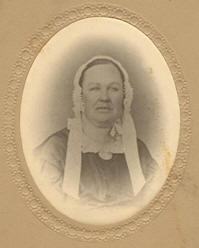 |
John and
Frances moved from Virginia and settled on the “Moss
White Farm” (three miles west of Marshall) Saline
County, Missouri in 1834. Together they established the
first boarding school in the county which they
maintained for ten years. John first built a house,
part log and part frame. He hauled lumber for the
flooring of his house from Chamber's mill, over the Big
Bottom. As the number of pupils increased, so did the
size of the Duggins mansion.
John and Frances had two children:
1.
ELIZABETH MARSHALL DUGGINS, b. 1828, Saline County,
Missouri;
d. 1904.
2. JOHN WILLIAM
DUGGINS, b. 1839, Saline County, Missouri.
In 1850, John and
Frances moved to Cambridge, Missouri. |
Cambridge, Missouri
After a change in the channel
direction of the Missouri River destroyed the town of Jefferson,
Missouri in 1845, a settlement developed less than a mile down
river which was to become known as Cambridge.
The town adopted its
name from the township and one supposition is that the name
Cambridge came from Cambridge, Mass., and the fact that the
first county clerk, Benjamin Chambers, son of a revolutionary
war general who won fame at the battle of Cambridge, was
probably the reason the town was given the name. Frederick A.
Brightwell, the first businessman and the first postmaster of
Cambridge is credited with giving the town the name although
there is no historical validation.
Although Cambridge was first occupied in 1845, it was not until
1848 that the town itself was regularly laid off. By 1876 the
population had grown to around 450 people. Among other
businesses and at various times there were four general stores
dealing in dry goods, hardware and groceries, a harness shop,
two drug stores, one or two tobacco factories, hemp bailing
machines, a tin and hardware store, steam mill, wagon maker’s
shop, blacksmith shop, and a grog shop that was heavily
patronized on Saturdays. The town well with its oaken bucket
was at the south end of Main Street.
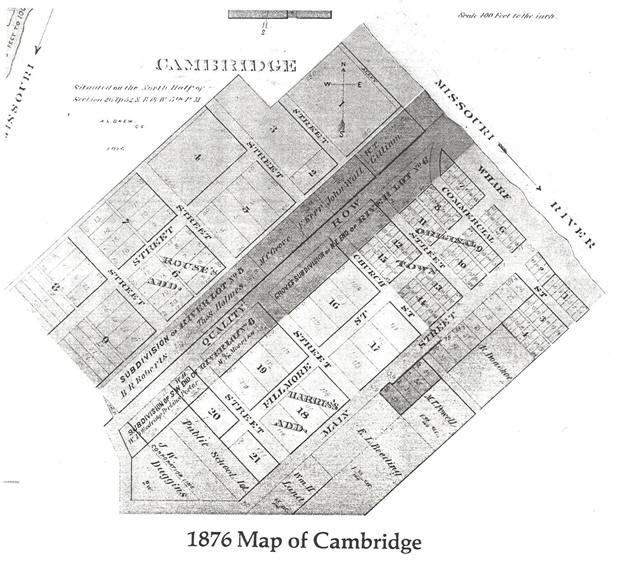



 |
The town had
a levee, or wharf, as it was called where the steamboats
landed. The wharf was graded to an even slope from the
top of the river bank to the water’s edge and paved with
limestone. It was during these years and prior that the
town enjoyed its greatest days of prosperity, when busy
boats plied their trade up and down the Missouri River
carrying cargoes of necessities and luxuries and
sometimes entertainment from the outside world inland,
and returning with cargoes of just as much necessity
such as pelts, hemp and tobacco to the outside world.
There was a school and a Methodist
church. The church had originally been organized in
1837 in a school house in Jefferson. As Cambridge
itself began to build up, the place of the church
meeting was changed to Cambridge and in 1853 a house of
worship was erected. Years later the church merged with
the Gilliam Methodist church.
One parishioner
recalled the hymns were started by a leader who, by the
trial and test manner using a tuning fork, established
the right pitch for singing. The women sat on the west
side of the church with the men on the east side. The
“amen Corner” was in the northwest part of the church
and usually occupied by the older members. A gallery
for the colored members was in the rear of the church.
The church was
later occupied by Wisconsin troops at the close of the
Civil War and a stockade built around the church.
The first mill
in Saline County was built in 1817 about one mile below
Cambridge. It was operated by horse power and only
ground corn and wheat. During the heydays in Cambridge
a Mr. Donahoe operated a mill in Cambridge that was
equipped with a single cylinder steam engine. This
ground the grain between two old-time millstones. The
flour was sifted through cloths that held the chaff and
the bran.
Wyatt Earp,
noted frontiersman and gun fighter, once lived near this
community. Nicholas P. Earp and his family came to the
county around 1870 and lived on a farm two and one-half
miles east of Gilliam. Nicholas had four sons, Virgil,
Morgan, Wyatt, and Warren and one Daughter, Adelia.
They lived there until 1877 when Nicholas and his wife
and youngest son, Warren, moved by covered wagon to
California. The three older Earp brothers moved to
Dodge City some years before.
With the building of
the Chicago and Alton Railroad, or rather by its
location away from Cambridge, and the building of the
towns of Slater and Gilliam, Cambridge was abandoned. |
John D. Duggins died
July 22, 1865 in Fulton, Missouri, at 69 years of age. His
body was interred in Cambridge. Francis Elizabeth Dickinson
died May 27, 1880 in Fulton at 72 years of age. Her body
was also interred in Cambridge.
|

John D. Duggins
1796-1865
Good Hope Cemetery
Cambridge, MO
|

Frances Elizabeth
Dickinson
1807-1880
Good Hope Cemetery
Cambridge, MO |
JOHN WILLIAM DUGGINS was
born in Cambridge, Saline County, Missouri November 16, 1839.
John assisted his father in management of his farm of 1,200
acres. He followed farming all his life, except four during
which he served as township constable and three years in
Confederate service, under the command of General Shelby.
The Fifth Missouri
Cavalry was organized in the spring of 1862. The regiment was
known frequently by its nickname, or local designation, of the
Jackson County Regiment or the Jackson County Cavalry. A great
many members of the regiment were recruited in that county and
in nearby counties in western Missouri.
Like most Civil War
units the Fifth Missouri Cavalry was often known by alternate
designations derived from the name of its commanding officer.
Unofficial names for the Fifth Missouri included: Joseph O.
Shelby's Cavalry Y.M. Blackwell's Cavalry B. Frank Gordon's
Cavalry George R. Kirtley's Cavalry George P. Gordon's Cavalry
James Garrett's Cavalry George S. Rathburn's Cavalry D. R.
Stallard's Cavalry William H. Farrell's Cavalry.
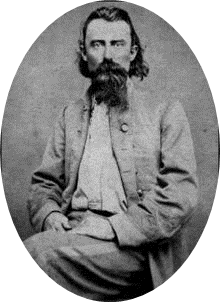
Joseph Orville Shelby
Joseph Orville "JO"
Shelby (December 12, 1830 – February 13, 1897) was born in
Lexington, Kentucky, to one of the state's wealthiest and most
influential families. He lost his father at age 5, and was
raised by a stepfather. Shelby attended Transylvania University
and was a rope manufacturer until 1852. He then moved to
Waverly, Missouri, where he engaged in steam boating on the
Missouri River and in running a hemp plantation. He was one of
the largest slaveholders in the state. During the "Bleeding
Kansas" struggle, he led a company on the pro-slavery side.
In 1861, Shelby formed a
cavalry company and was elected its captain, leading it into
battle at Wilson's Creek. Promoted to colonel, he commanded a
brigade at Prairie Grove. Shelby led his "Iron Brigade" of
Missouri volunteers on what was to be the longest cavalry raid
of the war at that time, Shelby's Great Raid.
Between September 22 and
November 3, 1863, Shelby's brigade travelled 1,500 miles through
Missouri, inflicting over 1,000 casualties on Union forces, and
capturing or destroying an estimated $2 million worth of Federal
supplies and property. He was promoted to brigadier general on
December 15, 1863, at the successful conclusion of his raid.
In 1864, Union General
Steele's failure in the Camden Expedition (March 23–May 2,
1864,) can in no small part be laid to Shelby's brilliant and
determined harassment, though in concert with other Confederate
forces. Ultimately that Federal force was forced back to Little
Rock upon the final destruction or capture of its supply trains
at Mark's Mill. Reassigned to the Clarendon, Arkansas area,
Shelby accomplished the rare feat of capturing a Union tinclad
USS Queen City, which was immediately destroyed to avoid
recapture. As summer was ending Shelby then commanded a division
during Sterling Price's Missouri raid. He distinguished himself
at the battles of Little Blue River and Westport, and captured
many Union held towns, including Potosi, Boonville, Waverly,
Stockton, Lexington, and California, Missouri.
Shelby's adjutant was John
Newman Edwards, who later as editor of the Kansas City Times
was to almost single handedly create the anti-hero legend of
Jesse James.
After Robert E. Lee's army
surrendered in Virginia, General Edmund Kirby Smith appointed
Shelby a major general on May 10, 1865. However, the promotion
was never formally submitted, due to the collapse of the
Confederate government.
The Fifth Missouri
Cavalry served the Trans-Mississippi region throughout its
career. It served both in the Trans-Mississippi Department and
in the Army of Trans-Mississippi.
The Fifth Missouri
Cavalry was stationed near Shreveport, Louisiana when it
received the news of the surrender of the Confederate forces
east of the Mississippi River. The regiment was disbanded in
mid-May, 1865. General Shelby, along with approximately 1,000
of his remaining troops rode south into Mexico. For their
determination not to surrender, they were immortalized as "the
undefeated". A later verse appended to the angry post-war
Confederate anthem, "The Unreconstructed Rebel" commemorates the
defiance of Shelby and his men:
"I won't be
reconstructed, I'm better now than then. And for a
Carpetbagger I do not give a damn. So it's forward to the
frontier, soon as I can go. I'll fix me up a weapon and
start for Mexico."
Their plan was to offer
their services to Emperor Maximilian as a 'foreign legion.'
Maximilian declined to accept the ex-Confederates into his armed
forces, but he did grant them land for an American colony in
Mexico near Veracruz. The grant would be revoked two years later
following the collapse of the empire and Maximilan's execution.
Reportedly, Shelby sank his battle flag in the Rio Grande near
present-day Eagle Pass (TX) on the way to Mexico rather than
risk the flag falling into the hands of the Federals. The event
is depicted in a painting displayed at the Eagle Pass City Hall.
The memory of Shelby and his men as "The Undefeated" is used as
a distant basis for the 1969 John Wayne-Rock Hudson film by the
same name.
Shelby returned to Missouri
in 1867 and resumed farming. He was appointed the U.S. Marshal
for the Western District of Missouri in 1893, was a critical
witness for the defense of Frank James at his trial, and
retained the position until his death in 1897. He died in
Adrian, Missouri, and is buried in Forest Hill Cemetery, Kansas
City.
Slayback's Missouri
Cavalry Battalion was organized in northern Arkansas during the
late spring of 1864. Most members of the battalion appear to
have been recruited in Wright, Texas, Douglas, Christian,
Lawrence, Dade, Barton, Jasper, Newton, and McDonald Counties.
Some members had served in State guard organizations early in
the Warand in a number of regular and irregular organizations
subsequently. At various times during the battalion’s short
career its members of companies grew from four to seven.
The battalion was also
known by the names of: Alonzo W. Slayback's Cavalry Thomas J.
Stirman's Cavalry Albert R. Randall's Cavalry. The battalion
served its entire career in the Trans-Mississippi Department.
Two specific higher command assignments were: July 31, 1864
Unbrigaded, First Missouri Cavalry Division, Cavalry, Army of
Trans-Mississippi.
John W. Duggins enlisted in
Company E, 5th Missouri Cavalry in Saline County,
Missouri on August 18, 1862 by Col. J.O. Shelby.
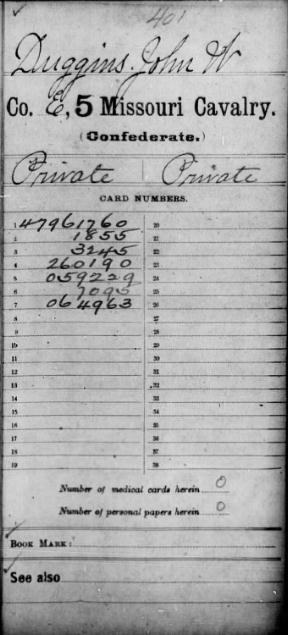 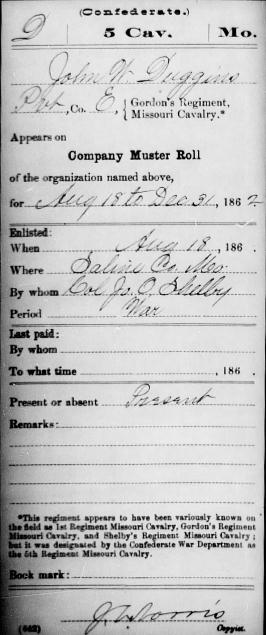
Co. E 5th Missouri
Cavalry
Company Muster Roll
August 18th – December 31st 1862
John W. Duggins, Private, Co. E Gordon’s Regiment, Missouri
Cavalry
Company Muster Roll
August 18th – December 31st 1862
Battle of Pilot Grove
Private Duggins fought in The Battle of Pilot Grove
on 7 December 1862. It resulted in a tactical stalemate but
essentially secured northwest Arkansas for the Union.
In late 1862 Confederate
forces had withdrawn from southwest Missouri and were wintering
in the wheat-rich and milder climate of northwest Arkansas. Many
of the regiments had been transferred to Tennessee, after the
defeat at the Battle of Pea Ridge in March, to bolster the Army
of Tennessee.
Following Pea Ridge, the
victorious Union General Samuel Curtis pressed his invasion of
northern Arkansas with the aim of occupying the capital city of
Little Rock. Curtis's army reached the approaches to the
capital, but decided to turn away after a minor yet
psychologically important Confederate victory at the Battle of
Whitney's Lane near Searcy, Arkansas.
Curtis reestablished his supply
lines at Helena, Arkansas, on the Mississippi River and ordered
his subordinate, General John M. Schofield at Springfield,
Missouri, to drive Confederate forces out of southwestern
Missouri and invade northwestern Arkansas.
Schofield divided his Army of
the Frontier into two parts, one to remain near Springfield
commanded by General Francis J. Herron, and the other commanded
by General James G. Blunt to probe into northwest Arkansas.
Schofield soon fell ill and overall command passed to General
Blunt. As Blunt took command, the two wings of his army were
dangerously far apart.
Confederate General Thomas
C. Hindman was an aggressive commander who had just been
relieved of overall command of the Trans-Mississippi District.
Hindman had issued a series of unpopular, but effective,
military decrees which gave political opponents ammunition to
have him removed from overall command.
Hindman maintained a field
command of Arkansas troops and, becoming aware of the Union
Army's precarious tactical position, convinced his replacement
to allow him to mount an expedition into northwest Arkansas.
Hindman hoped to catch the Union army in its divided state,
destroy it in detail, and open the way for an invasion of
Missouri.
Hindman's force gathered at
Fort Smith, Arkansas, and sent out approximately 2,000 cavalry
under General John S. Marmaduke to harass Blunt's forces and
screen the main Confederate force.
Unexpectedly Blunt moved
forward with his 5,000 men and 30 artillery pieces to meet
Marmaduke. The two clashed in a nine-hour running battle known
as the Battle of Cane Hill on 28 November 1862. Marmaduke was
pushed back but Blunt found himself 35 miles deeper into
Arkansas and that much farther from the remainder of his army.
On 3 December Hindman
started moving his main body of 11,000 poorly equipped men and
22 cannon across the Boston Mountains toward Blunt's division.
Blunt, disturbed by his precarious position, telegraphed Herron
and ordered him to march immediately to his support from
Springfield. Blunt did not fall back towards Missouri but
instead set up defensive positions around Cane Hill to wait for
Herron.
Hindman's intention was for
Marmaduke's cavalry to strike Blunt from the south as a
diversion. Once Blunt was engaged, Hindman intended to hit him
on the flank from the east.
At the dawn of the 7th of
December Hindman began to doubt his initial plan to move on Cane
Hill and instead continued North on Cove Creek Road with
Marmaduke's men in the front. Why Hindman changed his mind is
not known, but it is believed, as all generals, that he began to
doubt his initial strategy. Little did Hindman realize though
that this move would prove useful and allow his cavalry to
strike an early deadly blow to the 7th Missouri and the 1st
Arkansas.
Meanwhile, Herron's
divisions had performed an amazing forced march to come to
Blunt's rescue and met Marmaduke's probing cavalry south of
Fayetteville, Arkansas.
Hindman's characteristically
aggressive nature seems to have failed him at this moment.
Afraid that Blunt would be able to attack his rear, and facing
Herron to the north, Hindman chose instead to set up a defensive
position atop a line of low hills near Prairie Grove, Arkansas.
The battle opened on the
morning of 7 December with Union General Herron crossing the
river and deploying his footsore troops on Hindman's right.
Herron opened an intense two hour artillery barrage on the
Confederate position singling out individual Confederate cannon
and concentrating on taking them out of action one at a time. By
noon, the devastating barrage had disabled most of the
Confederate artillery and forced many of the Confederate troops
to shelter on the reverse slopes.
Seeing the effect of his
artillery, Herron ordered an advance on the hill rather than
waiting for Blunt to arrive. His troops first encountered
Confederate cavalry in the Borden wheatfield at the base of a
ridge overlooking the prairie. Herron took these advanced
troopers to mean that Hindman was planning to attack and capture
the Union artillery. So Herron sent forward two regiments from
his own 3rd Division to assault a Confederate battery near the
Borden house. When his men arrived on the hill they found
themselves under a fierce Confederate counterattack from three
sides by Maramaduke and Brigadier General Francis A. Shoup. Half
of the attacking Federals were wounded or killed within minutes,
most near the Borden House.

Borden House on the Prairie
Grove Battlefield
As the surviving Federals
rolled back down the hill toward the safety of Union lines,
Confederate soldiers spontaneously pursued and attempt to break
Herron's lines. Herron's artillery loaded with canister caused
terrible damage to the unorganized Confederates and repulsed
their attack.
Herron feared the
Confederates would make another rush at his artillery and
preemptively ordered another charge. This time two regiments
were selected from Daniel Huston's 2nd Division. Again near the
Borden house, hand to hand fighting ensued. The Federal troops
repulsed one counter attack before falling back towards Herron's
artillery. Again the pursuing Confederates rushed the Union guns
but were repulsed by troops from Colonel William W. Orme's
brigade.
Meanwhile, Blunt realized
that Hindman had gotten past his flank and intercepted Herron.
Furious, he ordered his men to march to the sound of the guns.
Not knowing the precise location of the fighting, the Federal
troops ignored roads and traversed through farm fields and over
fences straight toward the sound of battle at the double quick.
This movement was probably initiated by Colonel Thomas Ewing and
the 11th Kansas Infantry. While Blunt did not order the maneuver
he quickly endorsed it even chastising a regimental commander
for not showing enough initiative when he failed to follow the
unorthodox procedure. Blunt's forces arrived on the
field just as Hindman was ordering another attack on Herron's
forces. Blunt's division slammed into the surprised Confederates
and drove them back onto the hill. The heaviest casualties of
the battle were felt during this attack by the 10th Missouri
Confederate Infantry, which was caught in the open, at the flank
of the Confederate forces. Blunt aligned his two brigades and
sent them forward toward the Morton house on the same ridge to
the west of the Borden house. Blunt's forces fought somewhat
sporadically until being recalled off the ridge. Mosby M.
Parsons' Rebel brigade swept across the farm fields of prairie
toward Blunt's artillery. Once again the Union soldiers and
artillery repulsed the attack and darkness put an end to the
fighting.
During the night of 7 December
and 8 December Blunt began to call up his reserves. Hindman on
the other hand had no reserves remaining, was low on ammunition
and food, and had lost much of his artillery firepower. Hindman
had no choice but to withdraw under cover of darkness back
towards Van Buren, Arkansas. The Confederates reached Van Buren
on 10 December, demoralized, footsore, and ragged.
By 29 December Blunt and Herron
would threaten Hindman at his Van Buren sanctuary and drive him
from northwest Arkansas permanently.
Federal forces suffered
1,251 casualties and Confederate forces suffered 1,317
casualties. In addition, Confederate forces suffered from severe
demoralization and lost many conscript soldiers during and after
the campaign.
Though the battle was a
tactical draw, it was a strategic victory for the Federal army
as they remained in possession of the battlefield and
Confederate fortunes in northwest Arkansas declined markedly
from that point on.
The Muster Roll for
January-February 1863 notes that John W. Duggins was “absent”
for “detached service.” In February, he is listed as “sick in
hospital.”
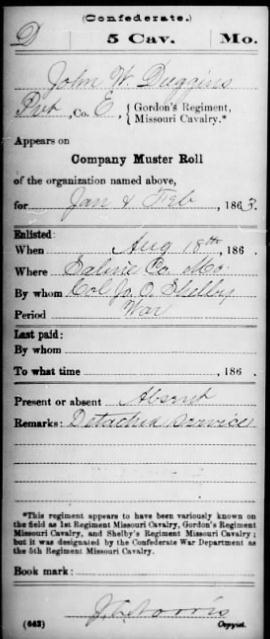
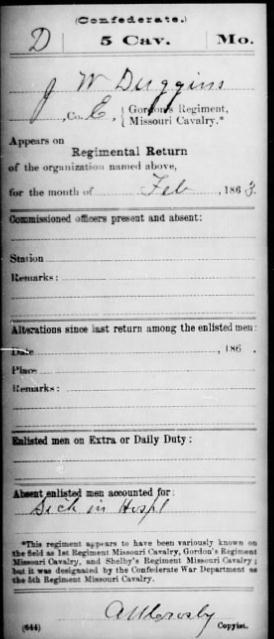
Co. E 5th Missouri
Cavalry
Company Muster Roll
January – February 1863
Regimental Roster
February 1863
One month later, on January 29th
1863, John W. Duggins was captured in Howell County, Missouri
and received at Gratiot Military Prison, St. Louis, MO on
February 8, 1863.
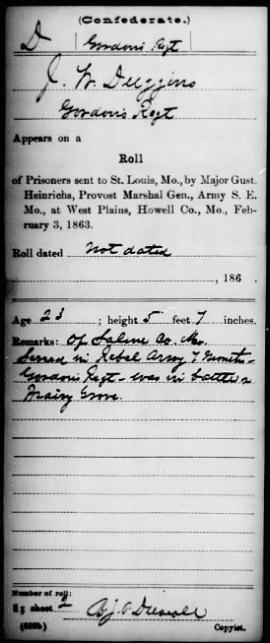
“ J. W. Duggins,
Gordon’s Regiment, Appears on a Roll of Prisoners sent to St.
Louis, Mo. by Major Gust. Heinrichs, Provost Marshal Gen., Army
S.E. Mo., at West Plains, Howell Co. Mo., February 3, 1863. Age
23; height 5 feet 7 inches. Remarks: of Saline Co. Mo. Served
in Rebel Army of___ Gordon’s Regt__in battle of _aizy ___.”
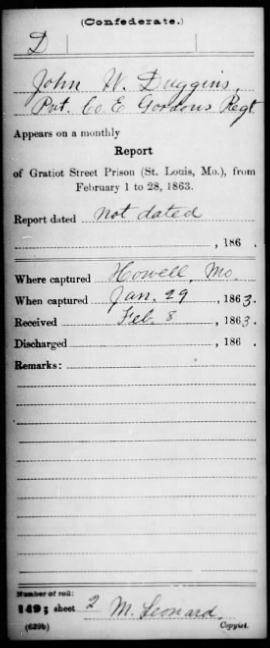
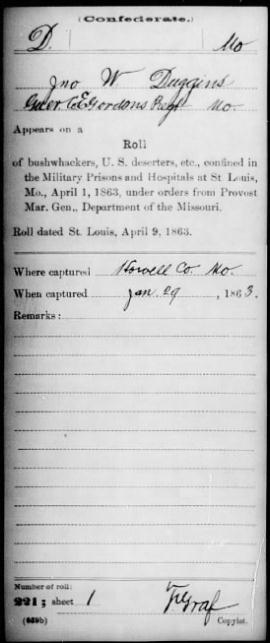

Gratiot
Street Military Prison
Gratiot Street Prison
served as McDowell Medical College before the war. The head of
the college, Dr. Joseph McDowell, was well known in the St.
Louis community as a doctor. He was also known for his strange
behavior and outspoken support for the South. Dr. McDowell
acquired two cannons that he kept at his college. He would
instruct his students to fire them on holidays. On one such
holiday he dressed in a colonial-style three-cornered hat and
instructed his students to “make Rome howl.”
When the war broke out,
McDowell made his way to the Confederacy, taking his cannons
with him. As with many known Southern sympathizers his property
was taken and became a barracks. Not long after, word came that
2,000 prisoners of war were on their way to St. Louis. A new
facility was needed when Myrtle Street Prison became
overcrowded. The McDowell Medical College building became
Gratiot Street Prison in December 1861.
During the Civil War
Gratiot Street Military Prison was operated in St. Louis,
Missouri by the Union army. Gratiot was unique in that it was
used not only to hold Confederate prisoners of war, but spies,
guerillas, civilians suspected of disloyalty, and even Federal
soldiers accused of crimes or misbehavior. The prison also was
centered in a city of divided loyalties. Escapees could find
refuge in homes not even half a block away. Many of the most
dangerous people operating in the Trans-Mississippi passed
through its doors. Some escaped in dramatically risky ways;
others didn't and lost their lives at the end of a Union rope,
or before a firing squad.
It was right in the
midst of some of the wealthiest homes in St. Louis. General
Fremont's headquarters in the Brant Mansion were only a block
away. Right across the street was the home of the wealthy
Harrison family. Attached to Gratiot on the north was the
Christian Brothers Academy. The biggest single escape was in
December 1863 when about 60 men escaped through a tunnel. Others
cut through the wall into Christian Brothers Academy where they
were--without hindrance--shown the exit. This is not to say
escapes came easily or without cost--a sizeable number were
killed in the attempts and others thwarted. Being in the
location it was, in the midst of often sympathetic houses, made
it easier to make good an escape. A safe hiding place could be
found often as near as half a block from the prison.
Most of the dead
prisoners were buried at Jefferson Barracks National Cemetery.
Some were claimed by families and taken home for burial.
Some--particularly smallpox victims--were buried in cemeteries
at the smallpox hospitals or on a Quarantine Island in the
middle of the Mississippi River.
The location is now the
headquarters of Ralston-Purina and has been for over a century.
The original Gratiot building was demolished in 1878.
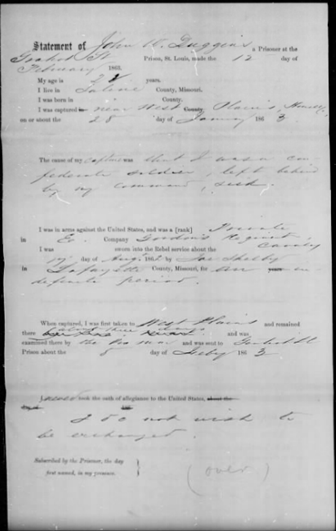 |
Statement
of John W Duggins a Prisoner at the
Gratiot St. Prison, St. Louis made the 12 day of
February 1863.
My age is 22 years.
I live in Saline County, Missouri.
I was born in " County Missouri
I was captured in near West
County Plains, Missouri
On or about the 28 day of January 1863
The cause of my capture was
that I was a con
federate soldier, left behind
by my command, sick.
I was in arms against the
United States, and was a [rank] Private
in E Company Gordon's Regiment Cavalry
I was sworn into the Rebel service about the
17th day of Aug. 1862 by Jos Shelby
in LaFayette County, Missouri, for an years
in
definite period.
When captured, I was
taken in West Plains and remained
there about three days and was
examined there by the Prison and was sent to Gratiot
Prison about the 8 day of February 1863
I do not wish to
be exchanged.
Selected by the Prisoner,
the day
first named, in my presence
|
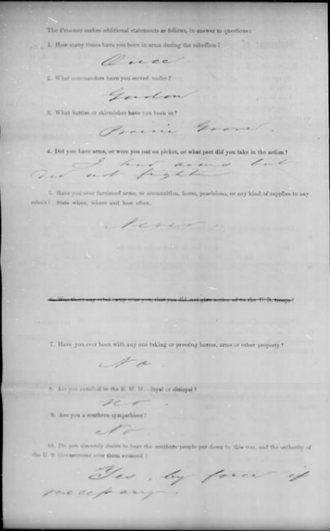 |
The Prisoner makes
additional statements as follows, in answer to
questions: 1. How
many times have you been in arms during the rebellion?
One
2. What commanders have you served under?
Gordon
3. What battles or skirmishes have you been in?
Pilot Grove
4. Did you have arms, or were you out on picket,
or what part did you take in the action?
I had arms but
did not fight
5. Have you ever furnished arms or ammunition,
horse, provisions, or any kind of supplies to any rebel?
State when, where and how often.
Never
6. Was there any rebel camp near you, that you
did not give notice to the U.S. troops?
7. Have you ever been with any one taking or
pressing horses, arms or other property?
No
8. Are you enlisted in the E.M.M. - loyal or
disloyal?
No
9. Are you a southern sympathizer?
No
10. It's your sincere desire to have the southern people
put down and the authority of the U.S. Government over
them restored?
Yes, by force if
necessary. |
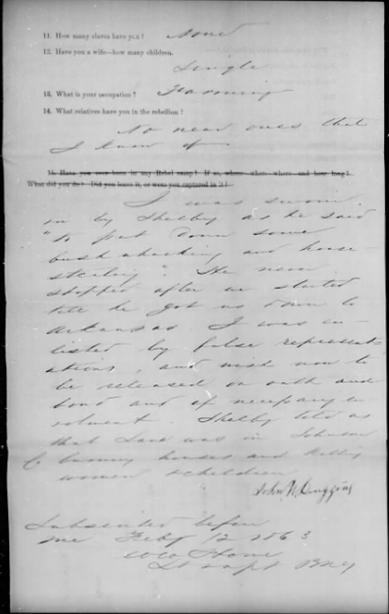 |
11. How many slaves have
you? None
12. Have you a wife - how many children.
Single
13. What is your occupation? Farming
14. What relatives have you in this rebellion?
No near ones that
I know of
15. Have you ever been in any Rebel camp? If so,
whose - when, where and how long? What did you do? Did
you leave it or where you captured in it?
I was sworn
in by Shelby as he said
"to put down some bushwhacking and horse
stealing." He never
stopped after we started
once he got us down to
Arkansas. I was en-
listed by false represent
ations, and wish now to
be released on oath and
bond and if necessary in
volvement. Shelby told us
that Davis was in Johnson
Co. burning houses and killing
women and children
John W. Duggins
Submitted before
me Feb 12, 1863 |
|
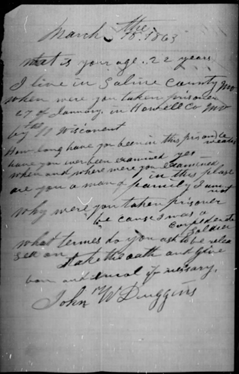
|
Prison Papers dated
March 18, 1863
What is your age. 22 years
I live in Saline County Mo
When were you taken prisoner
27 of January in Howell Co. Mo
by the 11 Wisconsin
How long have you been in this prison) 6 weakes
Have you ever been examined yes
When and where were you examined
in this place
Are you a man of family I am
not
Why were you taken prisoner
because I was a
Confederate
Soldier
What terms do you ask to be relea
sed on
take
the oath and give
bond and trial if necessary
John W. Duggins |
On April 24, 1863 Private Duggins was
released from Gratiot Military Prison on oath and bond of $2000
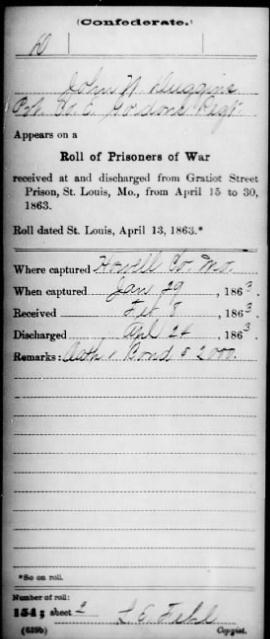
Bartels, "Trans-Mississippi
Men", p. 134, shows that John W. Duggins, enlisted as a
private in Company H, Slayback's MO Cavalry Regiment, November
1864, Thus it is apparent that he went with the army when it
passed through the area during Price's Missouri Raid in the fall
of 1864, and doubtless left the state with the army.
Slayback's Missouri Battalion participated in
more than fifteen various type engagements during its career. By
the time John William Duggins had re-enlisted (breaking his
oath) the battalion was greatly reduced and broken down by the
hardships of the campaign. The battalion retreated into the
Indian Territory, wintering there in the winter of 1864-1865. In
early 1865 the unit appears to have divided into at least three
small detachments. One of these moved to Shreveport, Louisiana,
where the Army of Trans-Mississippi had been consolidated.
This detachment
was included among the Confederate Trans-Mississippi troops
surrendered in early June, 1865. It is probable that it had
ceased to exist before that date, disbanding when the news of
the collapse of the eastern half of the Confederacy was
received. A second detachment was scouting near Pine Bluff,
Arkansas, when it learned of the surrender of the eastern
Confederacy. It appears to have surrendered to a detachment of
Kansas Militia at Pine Bluff on May 28, 1865. The third
detachment disbanded in southeastern Arkansas in early June,
1865. It is not known to which detachment John Duggins belonged.
On September 4, 1865,
John W. Duggins married Artemisia E. Hawkins. She was born
August, 19 1845. John and Artemisia had six children:
-
LUNA B. DUGGINS, b. 1866
-
OLLIE V. DUGGINS, b. 1868
-
SUSIE M. DUGGINS, b. 1871
-
KATE V. DUGGINS, b. 1873
-
JOHN T. DUGGINS, b. 1876
-
SPENCER M. DUGGINS, b. 1879
Twenty years after the
close of the Civil War, Higginsville, Missouri was the scene of
a re-union of the veterans of the Confederacy on Tuesday, August
25, 1885. Listed among the participants from Joseph Orville’s
Shelby’s Command was John William Duggins, Pvt. Co. E,
Gordon’s.
In 1892, John ran for the
office of County Assessor for Saline County. It is not known if
he was successful.
John William Duggins died December 3, 1902 in
Hammond, Louisiana, at 63 years of age. Artemesia E. Hawkins
died November 8, 1917 in Calloway County, MO.
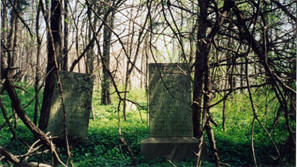
Headstones of
John W. Duggins
(left) and
Artemisia E. Hawkins (right)
Good Hope Cemetery
Cambridge, MO
 |